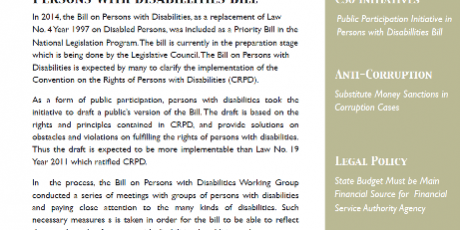CSO Initiatives
Public Participation Initiative in Persons with Disabillities Bill
In 2014, the Bill on Persons with Disabilities, as a replacement of Law No. 4 Year 1997 on Disabled Persons, was included as a Priority Bill in the National Legislation Program. The bill is currently in the preparation stage which is being done by the Legislative Council. The Bill on Persons with Disabilities is expected by many to clarify the implementation of the Convention on the Rights of Persons with Disabilities (CRPD).
As a form of public participation, persons with disabilities took the initiative to draft a public’s version of the Bill. The draft is based on the rights and principles contained in CRPD, and provide solutions on obstacles and violations on fulfilling the rights of persons with disabilities. Thus the draft is expected to be more implementable than Law No. 19 Year 2011 which ratified CRPD.
In the process, the Bill on Persons with Disabilities Working Group conducted a series of meetings with groups of persons with disabilities and paying close attention to the many kinds of disabilities. Such necessary measures s is taken in order for the bill to be able to reflect the actual needs of persons with disabilities. In addition, other measures taken were consulting with experts in order for the bill not only considers realities a person with disabilities has to deal with; but is also balanced with clear theories and concepts in solving existing problems.
The Working Group has already succeeded in formulating the first draft of the Bill on Persons with Disabilities. The draft will be circulated in order to get feedback from other parties, especially from disability communities who were not present on regular meetings and forums. The draft consists of 15 Chapters and 238 Articles, regulating 15 specific areas from education, health, law, politics, religion, culture, to public service. The many fields regulated is an inevitable consequence because the paradigm of fulfilling rights of persons with disabilities is no longer perceived as an act of charity, but instead to fulfill a citizen’s right. (FN)
Anti-Corruption
Substitute Money Sanctions in Corruption Cases
The specifics of corruption as a crime demand special treatment while imposing sentences. For example, aside from corporal punishment, there has to be an effort of reversion towards state losses caused by corruption. Beforehand, the type of punishment recognized in the Criminal Code was only limited to principal and additional sanctions. Through Article 34 letter c of Law No. 3 Year 1971 on the Eradication of Corruption Acts, a new sanction was introduced, namely the substitute money sanction. This sanction was then rearranged in Article 18 paragraph (1), (2) of Law No. 31 Year 1999 as amended by Law No. 20 Year 2001 on the Eradication of Corruption Acts.
In practice, there has been a sufficient amount of corruption cases where the perpetrators are also fined with the substitute money sanction, such as the cases of Djoko Susilo, Angelina Sondakh and Susno Duadji. Even so, substitute money sanctions also has its own problems, one of them being the calculation mechanism by the length of prison time if the convicted is unable to pay the amount set by the Judge. According to Article 18 paragraph (2) and (3) of the Law on the Eradication of Corruption, such inability will be converted through property confiscation. If it still considered insufficient, then the perpetrator will face imprisonment. In many cases, the Attorney General and Supreme Court have a hard time in determining the length of imprisonment.
Supreme Court Justice Suhadi suggested the following formula: the difference from the total amount paid by the convicted subtracted from total amount of substitute money, divided by a five-year subsidiary. For example; the total amount of substitute money is 10 billion. The total amount the convicted is able to pay is 5 billion. 10 million divided by 5 million equals to 2 million. The 5 year subsidiary is then divided by this number. Therefore, 5 years divided by 2 equals 2,5; this is the total number of years for imprisonment. In addition to this formula, there is in fact another effort that can be made, which is shifting the viewpoint of substitute money; from “state loss” to “profits obtained” of the convicted.
This is what must be postulated and proven by the public prosecutor. In addition, Article 18 paragraph (1) of the Law on Corruption Eradication has already made room for this point, which is “the payment of substitution money with the maximum equal to the possessions obtained from the corruption act”. Therefore it can be said that difference of the amount of substitute money can be reduced, although difficult to prove. Another matter should be considered is how to build supervision towards the payment of substitution money from the convicted to the Attorney General. (MSG)
Law Policy
State Budget Must be Main Financial Source for Financial Service Authority Agency (Otoritas Jasa Keuangan)
When Law No. 21 Year 2011 on the Financial Service Authority (Otoritas Jasa Keuangan/OJK) was enacted, some did not realize the substance of Article 34 paragraph (2) which regulated that OJK’s budget is sourced from the State Budget and/or contributions of financial companies. However, since the issue arose, followed by the enactment of Government Regulation No. 11 Year 2014 on Levies by OJK, they themselves have become the main target of the financial industry’s protests. Many of these protests question the OJK levies, especially the annual levies of 0,03% from the total of the company’s assets in 2014 and up to 0,045% to be implemented in 2016.
Referring to the Explanatory Provision of Article 34 paragraph (2), it clearly states that the lawmakers of the OJK Law prioritized OJK funding to come from outside the State Budget. For OJK, the State Budget is only needed if the levies are insufficient for the operational needs of OJK. This is understandable, keeping in mind that the financial sector is the one that needs a large budget, and if the State Budget becomes the main source, then the State will be in shortage. As of 2014, the OJK’s budget has reached up to more than Rp. 2 trillion.
The status of levies as the main source of budgeting has raised questions regarding OJK’s status itself as a state institution. In addition, Article 1 paragraph 1 of the OJK Law define the agency as the only authoritative independent institution in supervising the financial sector, without any mention of the state. The main source of budgeting and absence of the mentioning of the state has made OJK normatively not a state institution. However, we must not view this from only one perspective.
A state institution is an institution whose budget is funded wholly or partially by the State Budget. In this context, the state’s budget becomes the main source for OJK, which was essentially established as an independent state institution by its lawmakers. It is because of this reason that the main source of budgeting for OJK should be from the State Budget. Therefore, levies by OJK are only complementary, used to cover operational cost shortages. Regarding the arrangement of budget allocation, it is OJK’s own personal strategy and policy to determine this without burdening the state and financial industry. (MFA)

